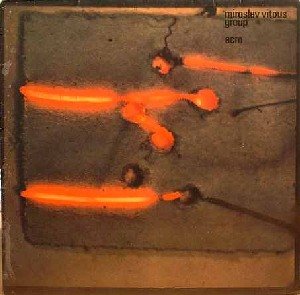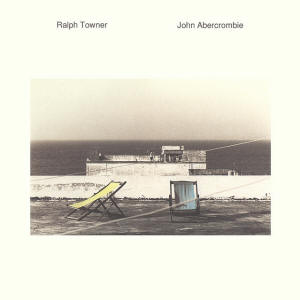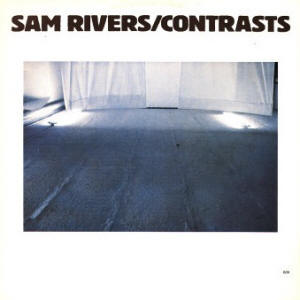You are reading the older HTML site
Positive Feedback ISSUE 75
Vinyl in the Round: ECM Re:Solutions
Mastered from the original 1970s era analog tapes and pressed in Germany on beautiful 180 gram vinyl (and also released on CD), ECM's Re:Solutions series brings to light recordings by vibraphonist Gary Burton, saxophonist Sam Rivers, bassist Miroslav Vitous, and the duo of guitarists John Abercrombie and Ralph Towner. Some of these recordings have been impossible to find on vinyl, others, like Abercrombie and Towner's Five Years Later, are a follow-up to previous successful recordings. And the vinyl is superb: supremely flat, heavy and dead quiet. ECM's lengthy back catalog (dating from 1969) is one of the most revered in jazz, and from their earliest recordings, producer Manfred Eicher created a sound as singular as anything from Blue Note, Riverside or Prestige. Yet, many of the label's ‘70s titles remain oddly under the radar, perhaps due to myopic American tastes. Yet ECM provides an example of a stellar European jazz label whose artists incorporate many strains and styles of music, and the label remains robust with such artists as Keith Jarrett, Charles Lloyd, Enrico Rava, Vijay Iyer, Paul Bley, Bobo Stenson, Tomasz Stanko, Billy Hart, and many more.
Miroslav Vitouš Group (ECM 1185) The oddly eponymous Miroslav Vitous Group follows 1979's First Meeting, both albums with the line-up of Vitouš, double bass; John Surman, soprano/ baritone saxophones, bass clarinet; Kenny Kirkland, piano; and Jon Christensen, drums. This group would record three albums in total. Between ‘79 and 1982, the group was the main outlet for the improvisational skills of leader Vitouš and John Surman. This was years after Vitous' membership in Weather Report, and such vaunted recordings as Chick Corea's Now He Sings Now He Sobs, where the bassist's lightning agility, Scott LaFaro like enunciation and wiry walking bass lines helped spread him a popular, globally recognized musician. As leaders, Vitouš and Surman were well-matched, with influences that extended beyond jazz, a love of "new thing" playing, and a direction fuelled by wrestling all the sound from their respective instruments: Surman's belch/singing at the top of the baritone sax's range well matched Miroslav's fiddle-like arco dalliances on the double bass. The ever-resourceful Jon Christensen improvised as always at the top of his game, as did Kenny Kirkland, just 24 at the time of this session, on his way to becoming one of modern jazz's great pianists. Miroslav Vitous Group is a brilliant recoding, start to finish. The soon to become nearly a standard, "When Face Gets Pale" opens the record, its samba pulse providing a super rhythmical launching pad for heated improvisations. Surman's moose-like call is matched by Vitous' conversational, eloquent tones and Kirkland's chunky, driving solos. There's a sense of the physical and the ethereal at work here, Surman's aggressive earthiness balanced by Vitous meaty yet cerebral rhythms, with Kirkland framing the fiery double front line with a more musically logical attitude. Though given to time-defying solos, Kirkland always remains grounded, his bluesier notes bookending Vitous and Surman's rambunctious conversation pieces. From the Christensen-driven "Second Meeting" to the shimmering, dawn-like "Eagle" and the bass buckling walking line of "Gears," this quartet seems to be engaged in a musical tug of war, with no one giving in the reins, no one looking for slack or providing it. It's a powerfully rhythmic session, yet with moments of grace like closer "Sleeping Beauty," which at times sounds like one long, spiralling crescendo.
Gary Burton Seven Songs for Quartet and Chamber Orchestra (ECM 1040) A follow-up to Burton's previous collaboration with Michael Gibbs, 1973's In The Public Interest, Seven Songs for Quartet and Chamber Orchestra features an even larger palette in the choice of a quartet augmented by a chamber orchestra, and like many things in the late 60s early 70s, it must have seemed like a good idea at the time. Burton is accompanied by a typically stellar cast, practically the ECM house band of the time, including Mick Goodrick, guitar; Steve Swallow, bass; and Ted Seibs, drums. Joined by members of the Hamburg NDR Symphony Orchestra under the direction of Michael Gibbs (and performing his material), Seven Songs... sought to realize a large scale vision of jazz quartet integrated with orchestra, and while interesting, the project ultimately sounds dated. Gibbs' compositions, inspired by Messiaen and Charles Ives as well as Miles Davis and Gil Evans, are richly colourful, written in broad swatches of music that are times engrossing, other times melodramatic. And while the integration of the jazz quartet with orchestra sounds mostly natural, at times the music sounds forced and almost programmed, as if everyone is reading the charts. Less than natural the music sounds purposely weighty and self-important, akin to some late 50s jazz-meets-orchestra productions that recall movie soundtracks more than clever concepts designed to inspire great soloing and improvisation.
Ralph Towner / John Abercrombie Five Years Later (ECM 1207) Another follow-up! Originally released in 1982, Five Years Later was the successor to this duo's equally resplendent outing, Sargasso Sea, only more developed and concentrated, and in Abercrombie's case, making even better use of then current guitar effects and technology. With Abercrombie performing on acoustic and electric guitars, electric 12-string guitar and mandolin guitar, Towner kept it simple, yet stunning, playing 12-string and classical guitars. When these two musicians occupy a room, something magical happens. They play contrasting instruments, yet beautifully reflect each other's styles and improvisations, bringing out the texture and tone of each set and improvised piece. And where the compositions are inspired, from the co-written "Late Night Passenger," Abercrombie's exceedingly lovely "Isla," and Towner's through-composed beauty, "The Juggler's Etude," it's the improvisations that reveal the duo's kinetic duality and mirror-like yet contrasting personalities at full force. The pair's serpentine unison performed melody in "The Juggler's Etude" creates a tapestry of balletic like movements, the guitarists' virtuosic solos recalling strains of English and Indian folk music. The neo folk jam of "Half Past Two" presents a fingerpicker's wet dream, the guitarists' brilliant playing both descriptive and jarring. The pair creates considerable relief when Abercrombie engages more of an electric tone to contrast Tower's lush acoustic, "Late Night Passenger" set in space by guitar synths, or perhaps it's Abercrombie's mandolin guitar. Later in the piece Abercrombie shoves a matchbook cover under his strings, creating a raspy effect that increases the funky or rougher nature of the guitar's tone. The combination of finger-picking and super high velocity execution creates a high bar with this opening track, and Five Years Later only gets better.
Sam Rivers Contrasts (ECM 1162) The late Sam Rivers was an important figure in jazz, striding many eras, and making multiple contributions to diverse movements within the art. His Blue Note recordings, Fuchsia Swing Song (‘64), Contours (‘65), A New Conception (‘66), and Dimensions & Extensions (‘67), remain highly sought after LPs, whether in their original Blue Note editions or as Liberty Blue Note releases. Even harder to find today are Rivers' Impulse! releases: Hues, Crystals, and Sizzle, all recorded during his innovative "Studio Rivbea" period. Co-founded with his wife, Bea, Rivers originated NoHo's now legendary loft scene, where musicians presented free jazz to the public under their own aegis, with no interference from business types or their demands. Rivers would go on to record on a variety of labels, yet this is his lone release for ECM. Marked by his keen compositions and playful tenor saxophone and flute improvisations, Contrasts also features George Lewis, trombone; Dave Holland, double bass; and Thurman Barker, drums and marimba By the time of Contrasts, Rivers and Dave Holland had been working together consistently for seven years (beginning with Holland's Conference of the Birds), a powerhouse combination of multi-reeds and double bass. The inclusion of Barker on drums and Lewis on t'bone only adds to the album's uniqueness. If anything, Barker, though a competent drummer who can swing well, and solos better, often sounds like a wannabe Believe It! era Tony Williams, his dull, thudding drum sound and zippy single stroke rolls providing an odd compliment to Holland's bass strength. Yet the pair swings strongly when walking a line. And befitting the often humorous nature of some Contrasts tracks, trombone innovator George Lewis is the perfect foil for Rivers' all-over-the-instrument approach. The song titles provide a clue to the album's interplay: "Circles," "Zip," "Verve," "Dazzle," "Lines." The stomping rhythm of "Circles" is further highlighted by Rivers' rollicking solo and Lewis' bone, which at one moment paraphrases the leitmotif cello notes of "Jaws." "Zip" recalls a New Orleans' parade of sorts, a herky-jerky melodic line giving way to straight ahead pacing, Holland's silken, powerful walking line against Barker's funky swing feel. This pair could walk you off the Brooklyn Bridge and you'd never feel the splash. "Verve" is more cosmopolitan and urbane, almost dipping into soul jazz terrain via a limpid backbeat, but the song's airy flute and clanging cymbal helps retain its cerebral stamp. Holland's bass solo is typically superb. "Dazzle" is all belching merriment, as Rivers blows a major head of steam, and Holland hammers a walking line of doom. Holland drops back into solo space, then switches gears between walking half-time and straight swing feels. The odd juxtaposition is heightened by Lewis' outer space like trombone riffing. Eventually all four return to the song's rather ghostly unison-performed main melody. "Lines" closes Contrasts, a gleeful song of chortling soprano sax blasts, bashing cymbals and walking bass. A curious close to a masterful recording.
|





